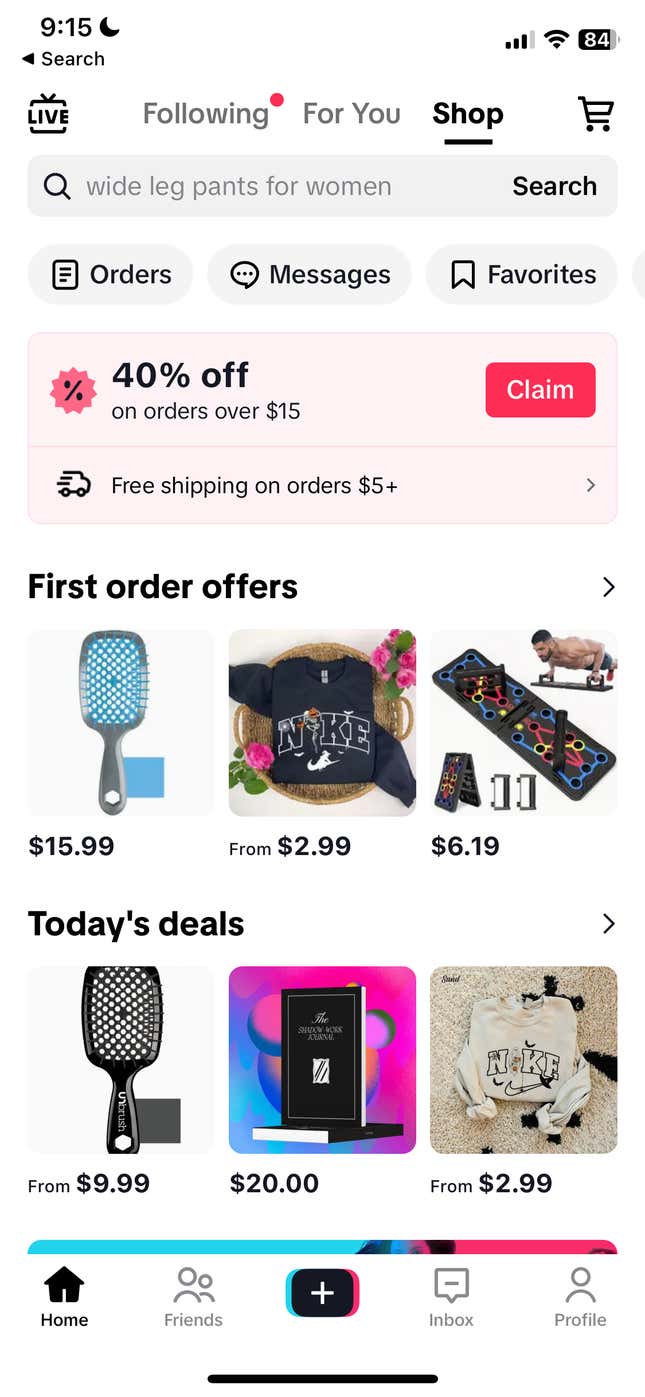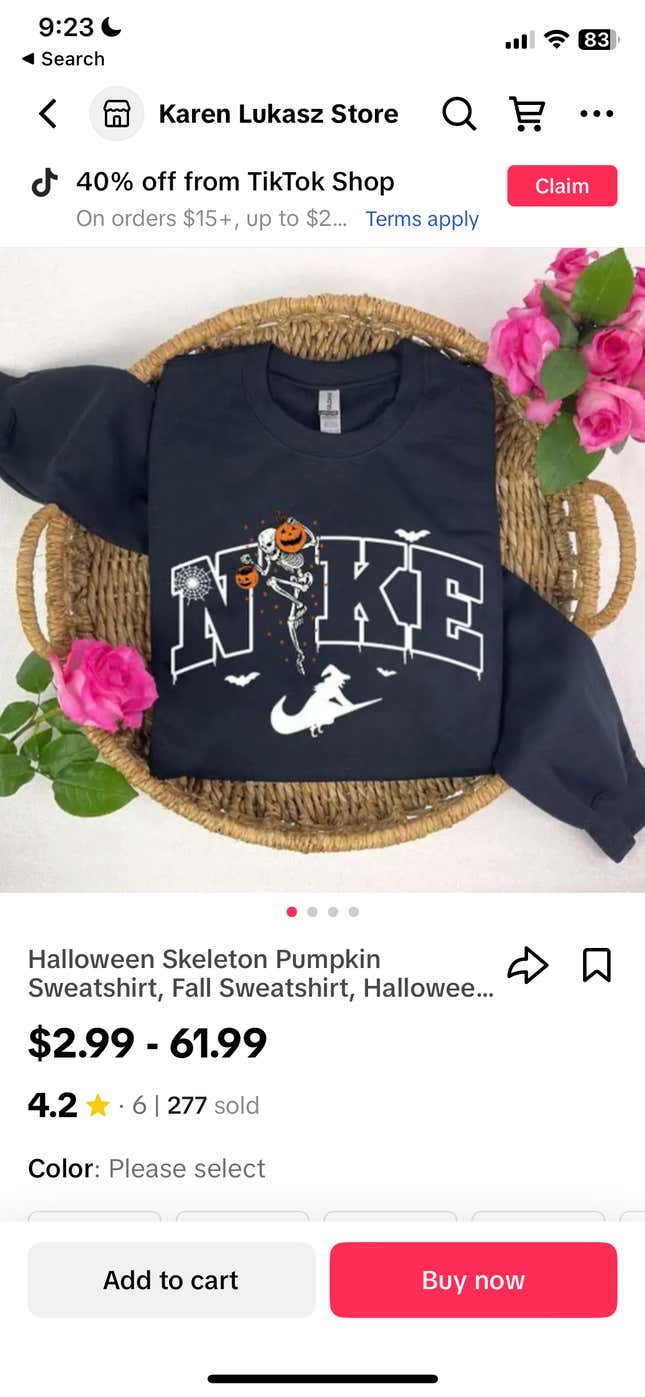
TikTok really wants me to buy a hairbrush. This past week, one popular influencer repeatedly tried to sell me what she called “the viral TikTok brush” as part of a paid advertising campaign. I also noticed smaller creators hawking it with a label explaining that they’d be paid a commission on any sales as part of a new affiliate marketing program.
Sure, why not? Influencers sell random stuff on social media all the time. But when I opened up TikTok Shop, the new feature on the popular app, the brush was everywhere. I mean, really everywhere. Each row or two of items had the brush—called the Unbrush Detangling Hair Brush. Stranger still, each brush was sold at wildly different price points.
In a brief tour of TikTok Shop, TikTok’s new effort to court US shoppers, I saw one brush selling for $9.99, another going for $15.99, and another selling for—wait for it—$37.98.
The prices were weird, but something else was much weirder. Nothing in the store seemed remotely related to my likes or interests, despite the fact that I’ve probably spent thousands of hours scrolling since I downloaded TikTok in 2019. (What app knows more about what I like than TikTok?)
I have no need for a new hairbrush, let alone a detangling brush. I’ve got short, straight hair that’s never been tangled in my entire life. Still, the brush keeps following me around TikTok. Other products seemed equally off-target: a $1.09 tongue scraper from a shop in China, a $14.99 four-pack of Scrub Daddy sponges, a $5.38 Stanley water bottle knockoff, and “futuristic narrow cyclops glasses” for $1.12. One item was a Halloween-themed imitation Nike sweatshirt sold by a woman in Minnesota at the confounding price point of “$2.99-61.99.”
It makes sense that TikTok would launch a shopping vertical. Social media companies, including Instagram and Pinterest, have long tried to become ecommerce players, but none have developed an online sales business as robust as Amazon or Etsy.
TikTok, however, may be the company best positioned to get users to buy stuff: It has more than 1 billion of them, and a large swath are Gen Z or younger. Plus, its app has been synonymous with internet culture in recent years, birthing countless fads and trends in music, pop culture, and, of course, shopping.
But a visit to the earliest incarnation of TikTok Shop was different. In fact, it was one of the strangest shopping trips I’ve ever been on.
Everyone is trying to sell you something on TikTok
After years of promoting itself as a place where people can find great products—see: the “TikTok Made Me Buy It” marketing campaigns—TikTok launched a formal marketplace on Sept. 12.
The social media app wants buying and selling to be a natural part of its flow: Watch a video, see a product, buy the product, keep scrolling. If you haven’t already, you may soon notice that TikTok has shoppable ads, an affiliate marketing program for creators who mention certain products, and shoppable static and live-streamed videos—something that’s been immensely popular in China but has yet to take off in the US. It’s even planning Black Friday deals to further entice users to buy discounted goods on the app.
TikTok may ultimately find success with its ecommerce ambitions, but its first week showed it wasn’t ready for prime time.
“TikTok has mastered media,” Jasmine Enberg, eMarketer principal analyst at market research firm Insider Intelligence, told Quartz. “It creates a sense of FOMO that no other social app has been able to achieve, and we already know that there’s nothing like a viral trend to get TikTok users to open up their wallets.”


But Enberg called the app’s new marketplace “a jarring departure from the entertaining, personalized experience that the rest of TikTok has to offer.”
Enberg’s colleague Max Willens, a senior analyst at the firm, called TikTok Shop’s offerings “not very curated, not very appealing, and generally kind of blah.” Willens thought the most redeeming aspect is the low prices of the selection, but “a lot of it is so cheap that it raises alarm bells,” he added.
Who wants to shop on social media?
Social media companies have long promised to turn their apps into digital shopping malls—or worse, a next-generation QVC. But TikTok’s dedicated marketplace is perhaps a surprising choice less than a year after Instagram shuttered its own.
And while shopping on social media is commonplace in China, where TikTok’s parent company, ByteDance, is based, it’s still a developing consumer habit in the US.
Market research firm Forrester says that American shoppers are hesitant to hand over personal information to social media companies, but also that they prefer to learn about new products via social media and then complete the transaction directly with the retailer.
“Social shopping experiences are often fraught with problems, including out-of-sync inventory feeds, poorly maintained social storefronts, and unclear return policies,” Forrester principal analyst Kelsey Chickering wrote in a blog post, noting that TikTok’s interface seems remarkably user-friendly. “If TikTok can improve the commerce experience, and make impulse buying easy, this creator-led social media platform is capable of closing the social commerce loop from discovery to purchase.”
Insider Intelligence’s Enberg said that TikTok has some advantages over competitors. In addition to its experience in China, the app caters to Gen Z, a cohort with still-forming shopping habits. “They also aren’t as concerned about privacy as older generations—many of them have grown up with social media and don’t know a world without it,” Enberg said.
The cheapest hairbrush on TikTok
The cheapest hairbrush I could find on TikTok Shop was listed for $0.04. It was very clearly a knockoff of the Unbrush. This cheaper brush was even marked down from its original price: $0.10.
I typed in my name and address and learned that shipping would cost me $14.99—the brush would be sent from Oklahoma—plus $1.12 in fees. The total price was $16.15.
I contacted the seller, listed only as “Boyce Brown,” to find out the motivation for selling a four-cent hairbrush on TikTok. If it wasn’t an outright scam, I wanted to know the strategy. Did they think they could game the system by selling in volume before other sellers flood the app?
But by the time of publication, unfortunately, the seller hasn’t responded. I haven’t completed the purchase and, thus, my hair remains unbrushed.